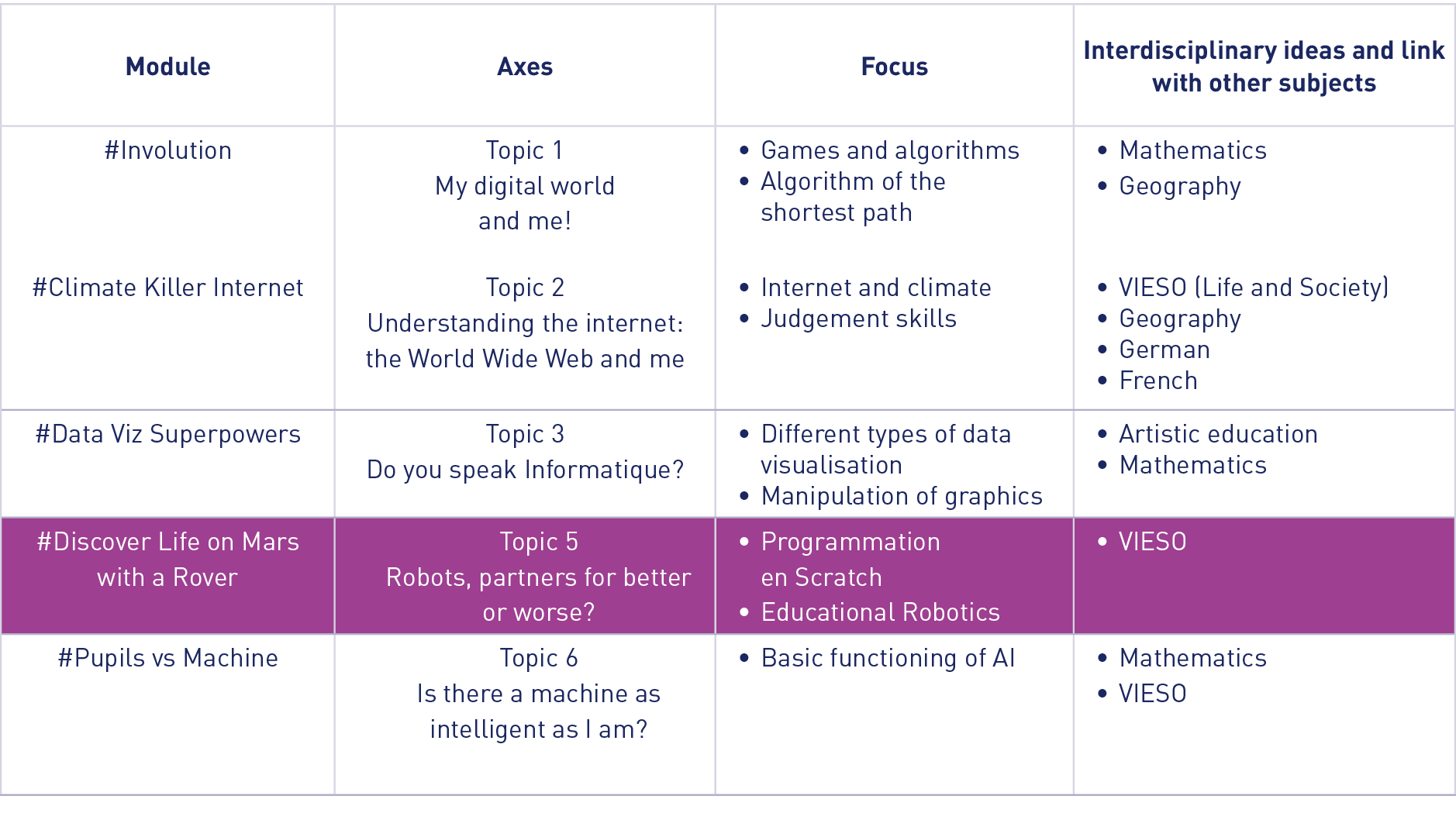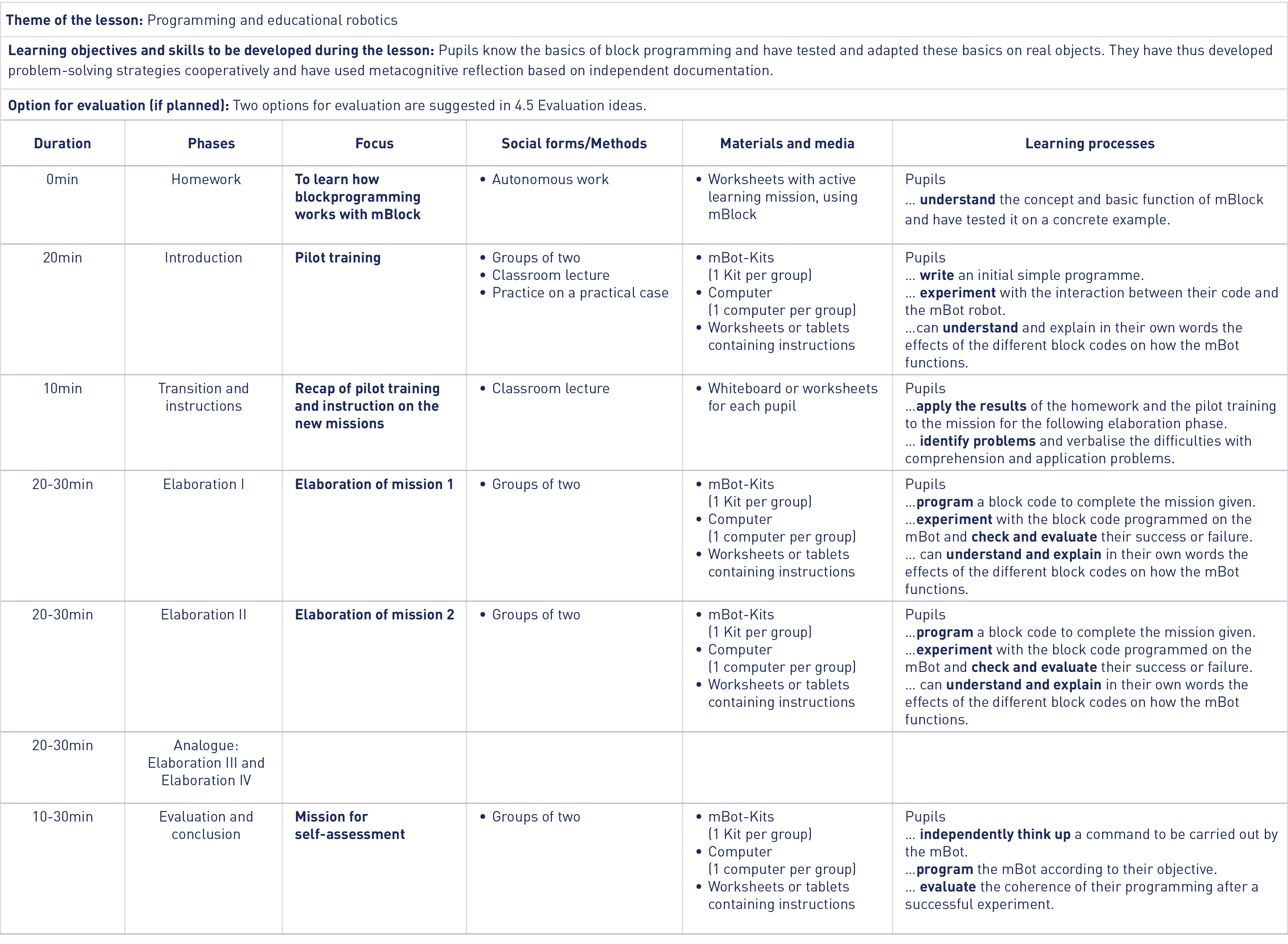The necessary equipment is loaned free of charge by ESERO (contact ESERO for this: contact@esero.lu or +352 621 96 90 19).
Discover Life on Mars with a Rover
4#Discover Life on Mars with a Rover

4.2 Lesson planning
01
Theme of the lesson in the overall structure of the axes

Since the modules are independent from each other, it is not necessary to be acquainted with the previous modules to tackle this one. If multiple modules will be completed, it is recommended that the #Involution module is scheduled before the #Discover Life on Mars with a Rover module.
This module was designed in collaboration with Frederic Cornrotte from ESERO Luxembourg. ESERO is the education branch of the ESA (European Space Agency). It takes space into classrooms by developing new, interactive, pedagogic media, by organising competitions and by offering regular training to teachers.
02
Conditions of unit
a) Target audience: 7e – 5e
b) Room: With the option to present it using a video projector.
c) Equipment required:
- free floorspace of 6 m2: 3 m x 2 m
In groups of 2 pupils:
- a laptop or PC with Windows or macOS
- an internet connection
- one available USB port
- mBlock software installed
The rest of the equipment is provided by ESERO (contact ESERO for this: contact@esero.lu or +352 621 96 90 19)
- A map of Mars
- The decoration equipment required for the challenges:
- 3 photos for decoration
- fixings to hold the photos
- a cave
- a soft toy tardigrade
- a heat source
- a Paxi soft toy, which is ESERO’s mascot
- Paxi stickers
- 10 mBots fitted with all of the necessary sensors, for a class of 20 pupils maximum.
d) No prior programming knowledge is necessary.
e) Duration: 100 minutes – 2 hours of teaching or 200 minutes – 4 hours of teaching
03
Contextualisation of knowledge
In February 2020, the Ministry of Education, presented the “einfach digital – Zukunftskompetenze fir staark Kanner” [Simply digital – Future skills for strong children] strategy, the objective of which is to prepare children and adolescents for the demands of the future, to help them navigate their way through an increasingly digital world and to enable them to acquire the necessary skills to do so. The new subject Digital Sciences was introduced within the framework of this strategy. Digital Sciences fits in with the coding taught in primary schools and focuses on six main themes: algorithms, the Internet, computing language, games, robots and artificial intelligence (Ministry of Education, 2020).
The #Discover Life on Mars with a Rover module follows on from the emphasis placed on coding and includes it in the themes of Space Education and Educational Robotics. On the one hand, this makes it possible to maintain the learning environments introduced in primary education with the Kniwwelino® micro controller, the Ozobot® educational robot, or even the Lux-Robo Modikit: the mBot robot used in this PITT module has corresponding sensors and (like the Ozobot®) it can be controlled through a block-programming environment. This means the previously-acquired coding knowledge can be reactivated and adapted (Ministry of Education, 2021).
Furthermore, the practical application and the scientific contextualisation within the framework of learning about space, allow pupils to make a real-world connection. The didactic feedback loops encourage an independent approach to learning programming languages.
04
Didactic transposition
a. Learning objectives and target skills
b. Didactic justification
c. Didactic reduction
Pupils know the basics of block coding and have tested and adapted them according to the application. They have therefore cooperatively developed solution strategies and used metacognitive reflection through independent research.
Competences from the Media Compass1
- Competences 1 – Information and data: 1.2 Analysing and assessing data, information and digital content
- Competences 2 – Communication and collaboration: 2:1 Working with others
- Competences 3 – Creating content: 3.3 Modelling, structuring and coding
- Competences 5 – Digital world: 5.1 Resolving simple technical problems
To ensure coding education and training is provided across primary and secondary education in line with digital sciences and to build up the level of skill detailed in the Media Compass1, this module provides more complex tasks based on block coding. The objective is “to identify aspects of real-world problems that lend themselves to IT modelling, to evaluate algorithmic solutions to these problems and to develop them in such a way that these solutions can be implemented by a computer” (Boualam et al., 2021). #Discover Life on Mars with a Rover therefore focuses on content for learning computational thinking and provides sample methods and tools to acquire the fundamental and essential skills to further develop their IT knowledge in future.
This module favours and supports abstraction skills and the ability to recognise the models required by computer modelling of real-world problems through the integration of educational robotics in the learning environment. In addition to increasing motivation for learning through fun coding missions and cooperative problem-solving methods, the responsiveness and clarity offered by robotic programming plays an essential role:
Numerous studies […] have shown that poor engagement and retention statistics in courses such as Introduction to Programming […] often arise from students’ inability to see how the skills they learn can have a concrete impact on what they care about: their physical world; their friends and family. Physical robot programming projects can cast coding problems into the real world, making those skills push back on one’s world and thereby achieve a level of significance and engagement that, for instance, computation of the Fibonacci Sequence on a computer screen cannot inspire. (Miller & Nourbakhsh, 2016)
The didactic principle of constructivist learning is thus transformed into constructionist learning, as Eguchi underlines, in line with Papert & Harrel (1991): “With constructionist learning, the object to think with is built or made, and what is physically constructed can be publicly shared – shown, discussed, examined, and admired” (Eguchi, 2017, 11). The possibility of using a robot to instantly check the coherence and function of blocks of code constructed independently using discrete and predefined programming instructions, facilitates self-directed learning, in which the feedback loops are given directly by the learning material used. The verification, discussion and adaptation of programming instructions in pairs aims to train the pupils’ metacognitive skills to consolidate the results of their learning.
05
Over the course of the lesson
The function and use of the mBlock user interface are studied by pupils at home before the next double lesson. This “flipped classroom” approach leaves more time to achieve the individual missions during the phase in school, and allows pupils to gain practical experience of using block coding before the lesson.
The lesson begins by a pilot training in pairs of pilots: at the start of the lesson, the pupils are divided into groups of two per prepared mBot kit. The pilot exercise is assigned and explained on a whiteboard and/or worksheets (in printed form or on tablets). Questions can be discussed, and responses given directly in group. As soon as all pupils have successfully completed their pilot training, the teacher can recap on the learning objectives of the pilots’ training then explain the next mission.
According to the level of knowledge, the group dynamic and the degree of internal differentiation required, it is possible to complete up to four missions per double lesson in the elaboration phase. It is equally possible to replace the last two missions with an assessment during which pupils will write a programme themselves, to achieve an objective they have thought up independently, using the mBot. If three to four lessons can be devoted to the module, there should be time to complete all of the missions and end them with an assessment.
All of the missions are constructed following the same blueprint and are explained in worksheets (in printed form or on tablets). For each mission you can download a sheet that contains part of the code. Consequently, pupils don’t have to program the entire mission, which allows those who are not familiar with Scratch to complete the module.
As soon as a mission has been completed, the next mission can be assigned. Take particular care to ensure that pupils comment on the codes used during the programming and experimentation with the mBot and reflect on their own work process.
Request a classroom intervention:
You can also contact us so that we can support you with this module in your class.
06
Differentiation possibilities
The option to graduate the missions individually allows for internal differentiation in the level of difficulty and performance. Each group determines the time it needs to complete the mission. Once a mission has been completed, they can move on to the next mission, which is more difficult. If more differentiation is required, teachers can allow pupils to program the missions from scratch. Instead of downloading the sheet that contains part of the solution, pupils can simply program on an empty sheet in mBlock.
07
Further criteria to be met as part of the lesson series
- The Luxembourgish context: the module is the result of a cooperation between ESERO Luxembourg (the European Space Education Research Office) and PITT. The learning objectives and target skills have been taken from the Media Compass and from axis 5 in the subject area of Digital Sciences.
- Differentiation: self-directed learning as well as graduation of the preparatory tasks according to the level of difficulty allows for multiple levels of differentiation.
- Media Compass: see the target learning objectives in the framework for education on media within the didactic transposition section in this document.
- The 4Cs model: Critical Thinking, Creativity, Cooperation, Communication. The 4Cs model is taken into account in various ways through the different social forms and teaching activities.
- Relation to current research: the design of rovers capable of navigating on the Moon or on Mars is a very current research subject in preparation for the next missions to the Moon and to Mars.
- Relation to current research in Luxembourg: the space industry and research in the field of space are being developed in Luxembourg. The University of Luxembourg’s role in space research is mentioned in the interview with Miguel Olivares-Mendez.
Referenzen
Eguchi, Amy. (2017). Bringing Robotics in Classrooms. In: Myint Swe Khine (Ed.), Robotics in STEM Education: Redesigning the Learning Experience. Cham: Springer, 3-31.
Miller, David P. & Nourbakhsh, Illah. (2016). Robotics for Education. In: Khatib, Oussama & Siciliano, Bruno (Eds.), Springer Handbook of Robotics. Second edition. Berlin/Heidelberg, 2115-2134.
Ministère de l`Education nationale. (2020). Dossier de presse du 06 février 2020: einfach digital – Zukunftskompetenze fir staark Kanner. https://men.public.lu/content/dam/men/catalogue-publications/dossiers-de-presse/2019-2020/einfach-digital.pdf, Zugriff am 04.02.2022
Ministère de l’Education nationale. (2021). EDI. Infomagazin fir Elteren 2, 23-26. https://men.public.lu/dam-assets/catalogue-publications/edi-infomagazin-fir-elteren/2021/02-2021-edi-infomagazin-elteren.pdf, Zugriff am 30.05.2022
Papert, Seymour., & Harel, Idit. (1991). Constructionism . New York, NY: Ablex Publishing Corporation.

